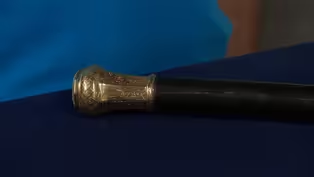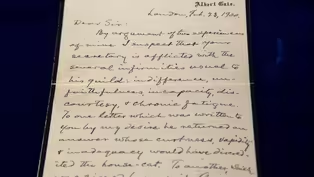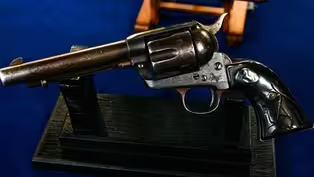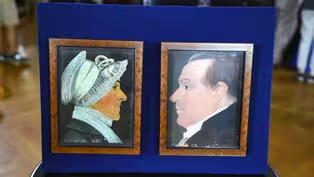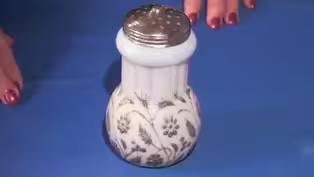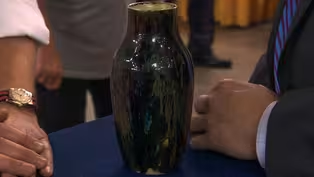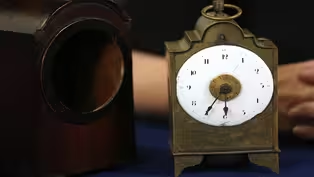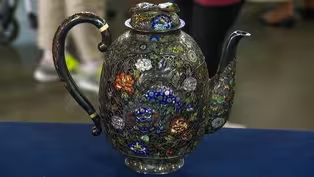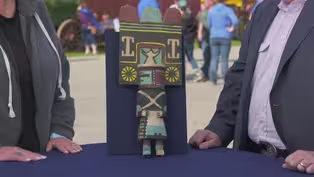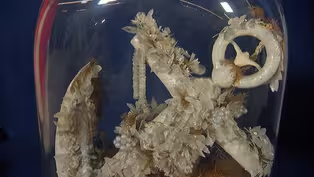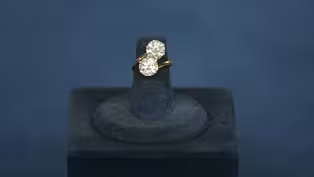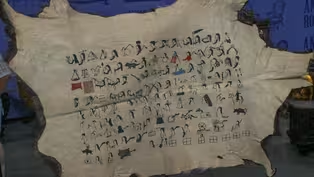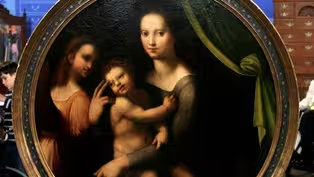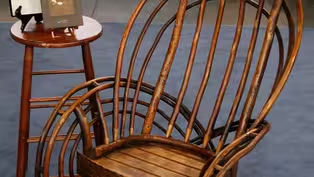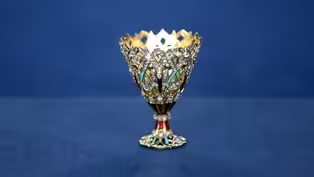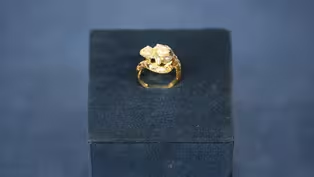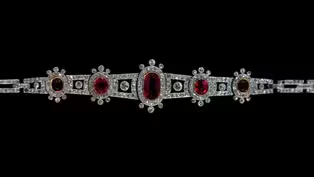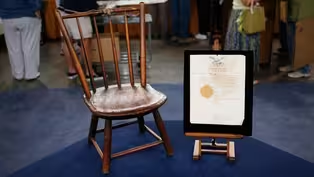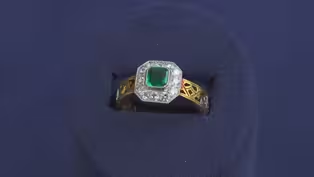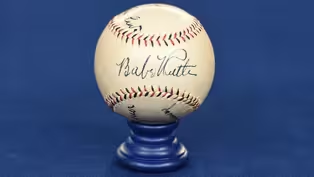
Appraisal: Concord, Massachusetts Card Table, ca. 1800
Clip: Season 27 Episode 23 | 2m 30sVideo has Closed Captions
Appraisal: Concord, Massachusetts Federal Card Table, ca. 1800
In Did Grandma Lie?, Christopher Barber appraises a Concord, Massachusetts federal card table, ca. 1800.
Problems playing video? | Closed Captioning Feedback
Problems playing video? | Closed Captioning Feedback
Funding for ANTIQUES ROADSHOW is provided by Ancestry and American Cruise Lines. Additional funding is provided by public television viewers.

Appraisal: Concord, Massachusetts Card Table, ca. 1800
Clip: Season 27 Episode 23 | 2m 30sVideo has Closed Captions
In Did Grandma Lie?, Christopher Barber appraises a Concord, Massachusetts federal card table, ca. 1800.
Problems playing video? | Closed Captioning Feedback
How to Watch Antiques Roadshow
Antiques Roadshow is available to stream on pbs.org and the free PBS App, available on iPhone, Apple TV, Android TV, Android smartphones, Amazon Fire TV, Amazon Fire Tablet, Roku, Samsung Smart TV, and Vizio.
Buy Now

ANTIQUES ROADSHOW 2025 Tour!
Enter now for a chance to win free tickets to ANTIQUES ROADSHOW's 2025 Tour! Plus, see which cities we're headed to!Providing Support for PBS.org
Learn Moreabout PBS online sponsorshipGUEST: The story in the family is that it was made by my great-great-grandfather in Concord, Massachusetts-- Cyrus Benjamin.
APPRAISER: Okay.
APPRAISER: And that's all I know about it.
It's been in the living room of my mother's house and my house for as long as I can remember.
APPRAISER: So family lore says it was made by Cyrus Benjamin.
GUEST: Cyrus Benjamin.
APPRAISER: About what time would that have been?
GUEST: It would probably have been-- we thought-- about 1860, 1870.
APPRAISER: Okay.
GUEST: About the time his son had gone into the Civil War, and he had a shop in the back of the house.
APPRAISER: Okay, well, as sometimes can happen, family history is off by a generation or two here.
A table like this is generally referred to as a demilune card table.
Made in eastern Massachusetts, about 1800.
So 60 or 70 years earlier than family lore would suggest.
GUEST: And before Cyrus Benjamin was born.
APPRAISER: Exactly.
This table, though it's based on a Boston example of a demilune table, is likely made, if not in Concord, certainly in the Concord, Massachusetts, area.
GUEST: That makes sense.
APPRAISER: Without a doubt.
It would be referred to as a Federal period card table.
It relates to Federal furniture made in Concord and Sudbury and Carlisle, all neighboring towns of the general area west of Boston.
GUEST: From where my relatives would have originated anyway.
APPRAISER: Exactly, which was the countryside at that time.
GUEST: Yes.
APPRAISER: It is a remarkably colloquial table.
GUEST: What does that mean?
APPRAISER: Well, there's a lot of country cabinetmaker things that are going on.
Especially with relation to the inlay on this table, which relates to a lot of Boston forms.
At the top of the dies here, you can see what I would refer to as a contrasting quatrefoil.
GUEST: I see.
APPRAISER: Very similar to a lot of furniture made in Concord, certainly.
What I like best, however, is the really delicate line inlay just below that, at the top of each leg.
You can see this maybe light wood, could be holly, wavy line inlay that sort of intersects a couple times, and then ends in drops that we looked at very closely and can't really determine exactly what the substance is.
It may be horn, it may be mother-of-pearl.
GUEST: Wow.
APPRAISER: It's difficult to know.
The whole table is covered over in a varnish that sort of obscures exactly what materials are being used.
But what's so interesting about the table to us is that it's a great country example of a city form made with indigenous woods like cherry on the top.
Actually two boards of cherry.
And it excited us when we saw it because it's a good rarity to have a table made in that area of Massachusetts.
Is it something you've ever had appraised?
GUESTL Never.
APPRAISER: Well, in its current state, we'd estimate it for auction purposes at $3,000 to $5,000.
GUEST: (chuckles) That will shock my brothers and sisters.
APPRAISER: (laughs) Well, good.
GUEST: Wonderful to hear.
I appreciate that, thank you very much.
Appraisal: 1873 California Gold Quartz Presentation Cane
Video has Closed Captions
Clip: S27 Ep23 | 44s | Appraisal: 1873 California Gold Quartz Presentation Cane (44s)
Appraisal: 1900 Mark Twain Letter
Video has Closed Captions
Clip: S27 Ep23 | 1m 20s | Appraisal: 1900 Mark Twain Letter (1m 20s)
Appraisal: 1903 Colt Single Action Army Revolver
Video has Closed Captions
Clip: S27 Ep23 | 2m 17s | Appraisal: 1903 Colt Single Action Army Revolver (2m 17s)
Appraisal: Benjamin Greenleaf Portraits, ca. 1810
Video has Closed Captions
Clip: S27 Ep23 | 3m 21s | Appraisal: Benjamin Greenleaf Oil Portraits, ca. 1810 (3m 21s)
Appraisal: Dalzell Findlay Onyx Muffineer, ca. 1889
Video has Closed Captions
Clip: S27 Ep23 | 1m 2s | Appraisal: Dalzell Findlay Onyx Muffineer, ca. 1889 (1m 2s)
Appraisal: Dedham Pottery Vase, ca. 1900
Video has Closed Captions
Clip: S27 Ep23 | 40s | Appraisal: Dedham Pottery Vase, ca. 1900 (40s)
Appraisal: French Campaign Clock, ca. 1790
Video has Closed Captions
Clip: S27 Ep23 | 42s | Appraisal: French Campaign Clock, ca. 1790 (42s)
Appraisal: French Porcelain Vases, ca. 1860
Video has Closed Captions
Clip: S27 Ep23 | 2m 56s | Appraisal: French Porcelain Vases, ca. 1860 (2m 56s)
Appraisal: Hiratsuka Filigree & Cloisonné Teapot, ca. 1895
Video has Closed Captions
Clip: S27 Ep23 | 1m 16s | Appraisal: Hiratsuka Filigree & Cloisonné Teapot, ca. 1895 (1m 16s)
Appraisal: Hopi Kachina Figure, ca. 1910
Video has Closed Captions
Clip: S27 Ep23 | 1m 57s | Appraisal: Hopi Kachina Figure, ca. 1910 (1m 57s)
Appraisal: Late 19th-C. Fish Scale-decorated Anchor & Dome
Video has Closed Captions
Clip: S27 Ep23 | 1m 8s | Appraisal: Late 19th C. Fish Scale-decorated Anchor (1m 8s)
Appraisal: Matched-pair Diamond Ring, ca. 1910
Video has Closed Captions
Clip: S27 Ep23 | 2m 57s | Appraisal: Matched-pair Diamond Ring, ca. 1910 (2m 57s)
Appraisal: Oglala Sioux Winter Count
Video has Closed Captions
Clip: S27 Ep23 | 3m 31s | Appraisal: Oglala Sioux Winter Count (3m 31s)
Appraisal: Oil Painting Attributed to Franciabigio
Video has Closed Captions
Clip: S27 Ep23 | 2m 44s | Appraisal: Oil Painting Attributed to Franciabigio, ca. 1520 (2m 44s)
Appraisal: Old Hickory Chair Company Rocker, ca. 1910
Video has Closed Captions
Clip: S27 Ep23 | 3m 14s | Appraisal: Old Hickory Rocking Chair, ca. 1910 (3m 14s)
Appraisal: Ottoman Zarf, ca. 1875
Video has Closed Captions
Clip: S27 Ep23 | 3m 47s | Appraisal: Ottoman Zarf, ca. 1875 (3m 47s)
Appraisal: Renaissance-revival Poison Ring, ca. 1875
Video has Closed Captions
Clip: S27 Ep23 | 3m 39s | Appraisal: Renaissance-revival Poison Ring, ca. 1875, in Green Bay Hour 2. (3m 39s)
Appraisal: Ruby & Diamond Bracelet, ca. 1895
Video has Closed Captions
Clip: S27 Ep23 | 2m 26s | Appraisal: Ruby & Diamond Bracelet, ca. 1895 (2m 26s)
Appraisal: Windsor Chair & Passport, ca. 1815
Video has Closed Captions
Clip: S27 Ep23 | 2m 39s | Appraisal: Child's Windsor Chair & Passport, ca. 1815 (2m 39s)
Appraisal: Diamond & Emerald Conversion Ring, ca. 1920
Video has Closed Captions
Clip: S27 Ep23 | 2m 57s | Appraisal: Diamond & Emerald Conversion Ring, ca. 1920 (2m 57s)
Appraisal: Ruth & Wagner Signed Ball, ca. 1933
Video has Closed Captions
Clip: S27 Ep23 | 3m 36s | Appraisal: Ruth & Wagner Signed Ball, ca. 1933, from Charleston, Hour 1. (3m 36s)
Providing Support for PBS.org
Learn Moreabout PBS online sponsorshipSupport for PBS provided by:
Funding for ANTIQUES ROADSHOW is provided by Ancestry and American Cruise Lines. Additional funding is provided by public television viewers.


